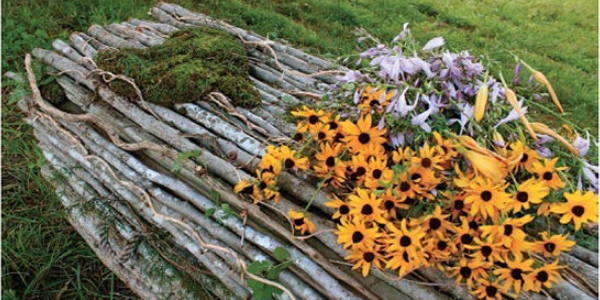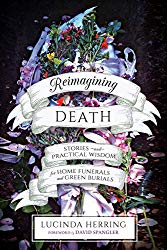
Reimagining Death: Stories and Practical Wisdom for Home Funerals and Green Burials, by Lucinda Herring
North Atlantic Books, 9781623172923, 296 pp., 2019
Reimagining Death: Stories and Practical Wisdom for Home Funerals and Green Burials arrived at my door in a brown paper wrapper. Unexpected, I wondered what was inside. Cutting carefully I opened the package admiring the heavy duty recycled paper used. A few days ago I requested to review this item. How quickly it arrived!
My eyes lit on the inside cover, “Praise for Reimagining Death.” Five leaders from differing areas of the natural death, green burial, conscious dying, and conservation burial movements praised Lucinda Herring for “reminding us all of a deep abiding wisdom we share as human beings.” Dedicated to her parents, both deceased, I realized Herring had lots of practical experience to share.
Like the author, the book contains a wide selection of personal experiences presented as stories that illustrate the main themes. The human-centred narrative helps to make the overall tone of the book very personal and quietly moving, while the data paired with the stories provides the information needed to contemplate such choices, and stimulate us to make the choices consciously.
Reimagining Death also contains illustrations. Flipping to the middle of the book I found 40 colour photographs of vigils, shrouds, casket painting and decorating, and photographs of dead bodies at home surrounded by flowers, dressed in their sacred best, wrapped in simple shrouds, laid out in biodegradable caskets, and being placed into the ground in backyards, nature preserves, conservation areas, and green burial cemeteries. The beauty inspired me.
The pictures captured the deep sense of the celebration of both the life, and the person deceased. Surrounded by friends and family, flowers and clothes, handmade hearts and sacred tools; the death, grieving and burial processes looked lush and celebratory, filled with the colours and details of the life lived. The photographs compelled me to jump right in with the text.
Each chapter starts with a poem, beautiful words that stimulate contemplation and deliver a deeper meaning. They set up a quiet rhythm of “read, pause, absorb… and read some more” that I used throughout the book. With so many stories about the experiences of dying, death, grief, letting go, sacred blessing and burial, the book is bursting with emotion.
“Turning toward death is not easy,” Herring writes, and I am aware of the deep feelings welling within me as I read, but, she writes,
if we can learn how to “resource” ourselves — which is a neurobiological term for calming ourselves down, resting, finding ways to inhabit the parasympathetic part of our brains, rather than the “fight, flight, or freeze” response form the sympathetic nervous system — then our threshold experience can often be less traumatic, more resilient and generative in the end.1
Carefully woven with essential information on laws effecting death and funeral processes, the growing green burial movement, the birth and growth of the Natural Home Funeral Alliance (NHFA) and Green Burial Council Reimagining Death is filled with resources. The resources section at the back of the book is generous, and lists organizations, books, films, websites, people, and where to find a natural burial site, and green burial products and supplies. While the large organizations governing green death and burial are listed separately, the remaining resources are organized by chapter reference — if you just want to find information on partnering with nature or conscious dying, you can flip to pages 245 or 251 respectively, and easily find it.
Having access to so much detailed information I felt relief. Now I can contemplate conscious dying and make green burial plans for myself. While I found there was little information specific to Canada (where I live) and its laws, there were a few threads of information that I later used for an Internet based search. While links to UK and Australian activists and organizations are listed, and a small nod given to a Canadian activist, the majority of the information is USA centred. However, the lack of Canadian specific information didn’t deter me. I found that the story telling, juxtaposed with data and statistics, the listings of American laws relevant to death and burial, and the overview of the important considerations really informed and inspired me. The data on the environmental impact of conventional burial was alarming. I learned that “we bury 827,060 gallons of toxic formaldehyde embalming fluid each year.”2 And that’s just in the United States.
Herring weaves her Earth-based faith into her storytelling, as other contributors weave their many and varied faiths into their stories. She tells both the stories of deaths and burials she has been part of, and stories of seeking training in line with her beliefs. The stories, posed with a backdrop of personal choice, spiritual practice, rituals and rites, provide instruction in ways to “soften trauma and suffering at the end of life and… bring people back into a more intimate and living relationship with death itself.”3
As much a book about consciously living as it is about consciously dying, Reimagining Death is something I will draw on for years to come as I age, write my own death plan, and help my family, friends and community contemplate conscious dying, sacred care of the dead, community death vigils, and green burials. I recommend it highly to anyone looking for choice and personal, spiritual involvement in the process of death and burial.









